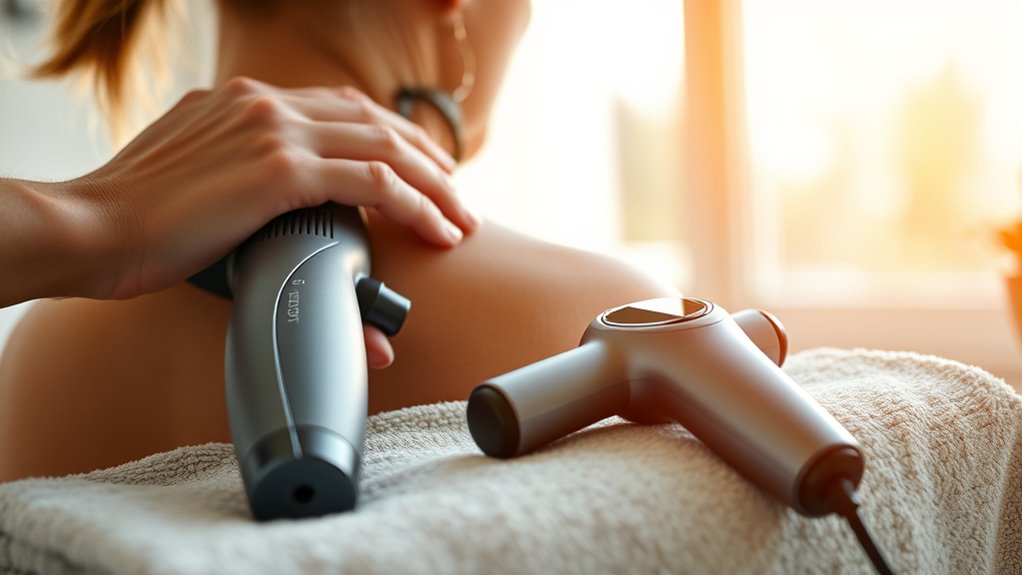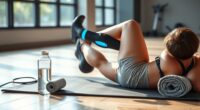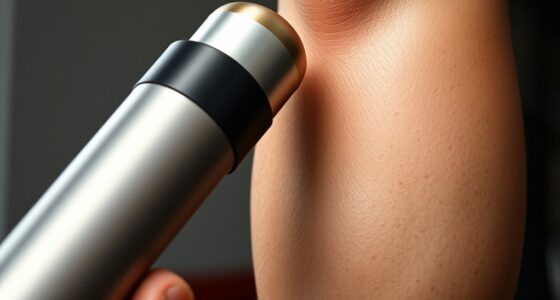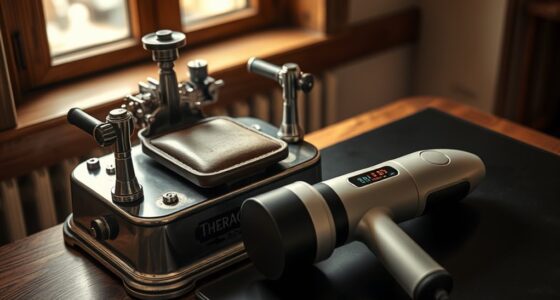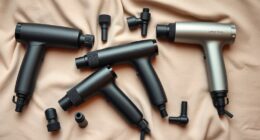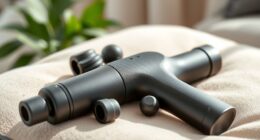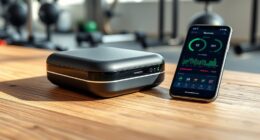Massage guns can’t replace the nuanced touch and real-time feedback of a skilled therapist. They have limitations in targeting complex muscle structures, often missing deeper knots or sensitive areas. Overuse or misapplication can cause tissue damage or nerve irritation. Human touch provides personalized pressure, emotional support, and adaptability, ensuring safer, more effective healing. To understand why combining both methods offers the best results, explore further to discover the essential differences.
Key Takeaways
- Human hands provide real-time feedback and personalized adjustments that devices cannot replicate for safety and effectiveness.
- Skilled therapists can interpret tissue responses and emotional cues, ensuring gentle, targeted, and safe treatment.
- Manual therapy addresses both physical and emotional needs, fostering trust, comfort, and holistic healing.
- Massage guns lack finesse and adaptability, risking tissue damage or discomfort if misused or applied excessively.
- Combining human touch with technology creates a comprehensive approach that maximizes benefits and minimizes risks.
The Limitations of Vibration and Percussion Devices
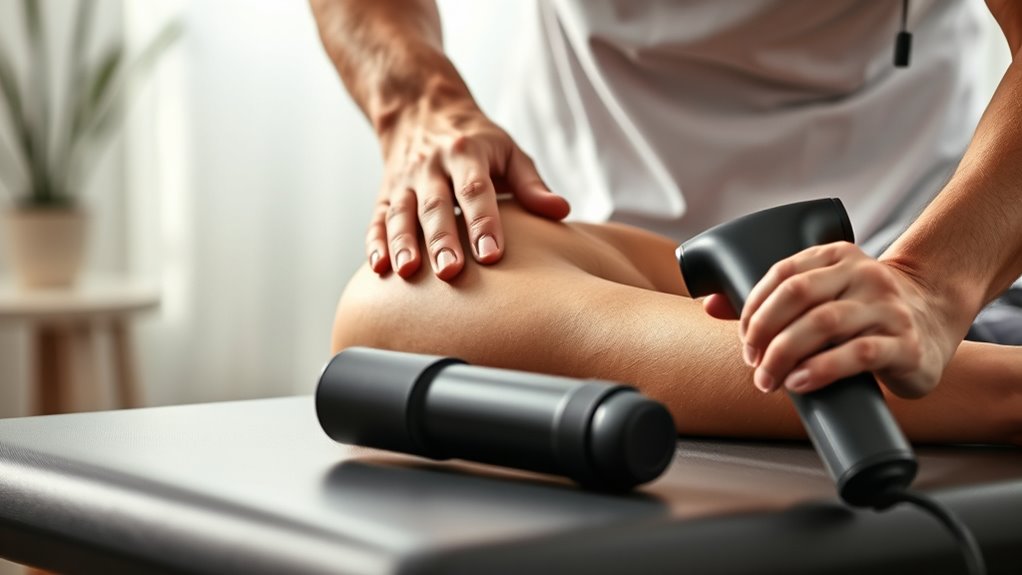
While vibration and percussion devices like massage guns can provide quick relief, they have clear limitations. Device limitations stem from their mechanical constraints, which restrict their ability to target complex muscle structures effectively. These devices deliver rapid pulses but lack the finesse of a human touch, making it difficult to adjust pressure precisely. Mechanical constraints mean they can only reach certain depths and may not adapt well to unique muscle shapes or sizes. As a result, they might miss deeper knots or sensitive areas that require gentle, nuanced pressure. Additionally, their rigid movement patterns can cause discomfort if used improperly. While useful for superficial muscle relief, these devices can’t replace the tailored, adaptable approach that human hands offer for exhaustive muscle care. Furthermore, understanding Gold IRA Rollovers can help individuals diversify their retirement investments, but it doesn’t replace the personalized attention a physical therapist provides.
The Importance of Personalized Treatment Approaches
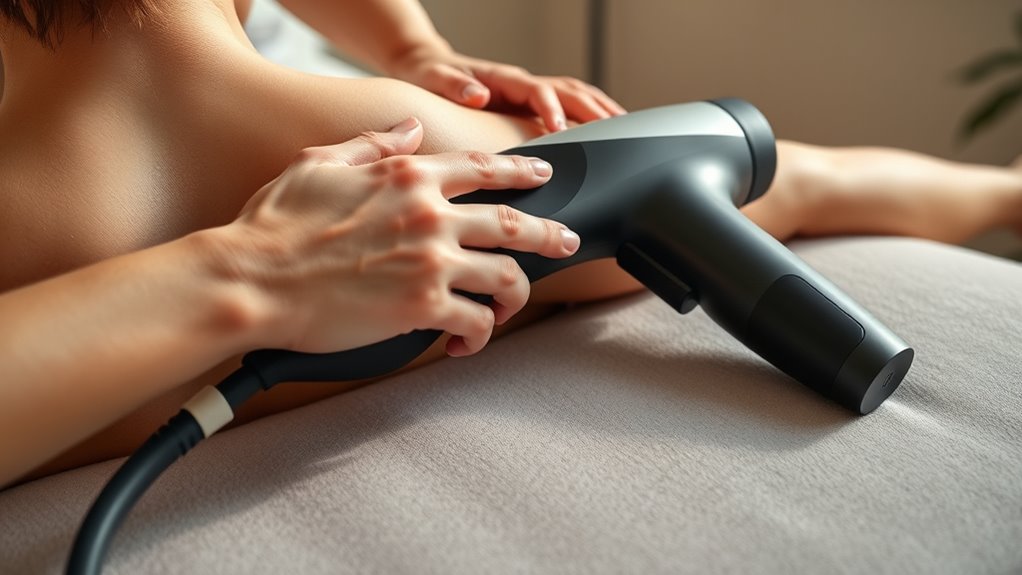
Massage guns and similar devices can offer quick relief, but they often fall short when it comes to addressing individual muscle needs. Personalized treatment approaches matter because they foster emotional connection and provide holistic care. A skilled therapist assesses your unique condition, adjusting pressure and techniques in real-time. This tailored approach respects your body’s feedback, ensuring effective and safe relief. Moreover, understanding muscle response can significantly improve treatment outcomes, highlighting the importance of expert guidance.
The Nuances of Tissue Response and Feedback
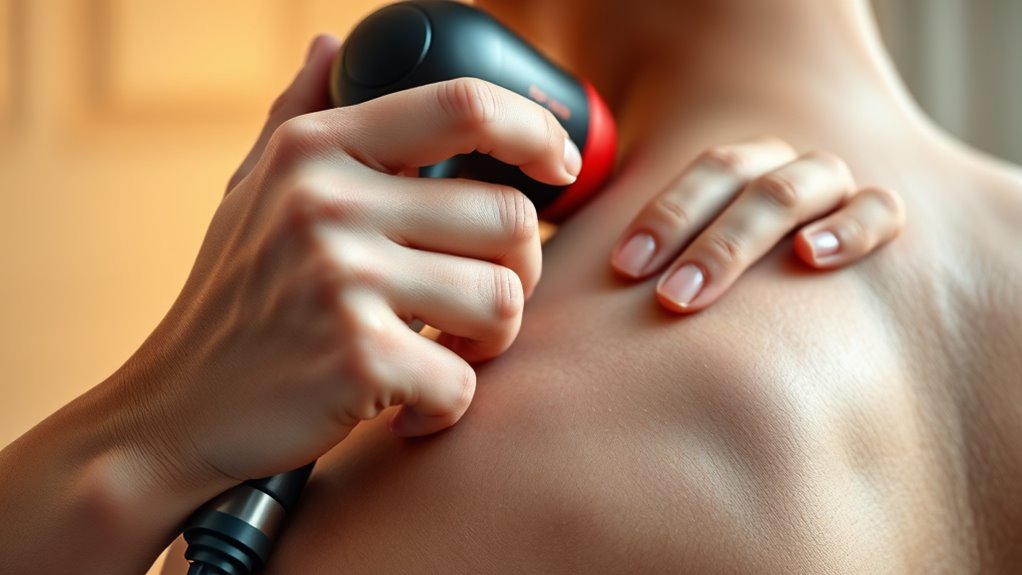
Your tissues respond differently to massage, so what works for one person might not work for another. Sensory input is complex, making it essential to pay attention to subtle feedback during treatment. By understanding these nuances, you can tailor your approach to meet each individual’s unique needs effectively. For example, recognizing how horsepower of electric dirt bikes influences performance can help in understanding the importance of precise pressure and technique during massage to avoid overstimulation.
Tissue Response Variability
Tissue response to massage guns varies markedly from person to person, influenced by tissue composition, pain threshold, and muscle conditions. Some tissues adapt quickly, showing a strong response, while others require more gradual stimulation. Your body’s response consistency depends on these factors, making uniform treatment ineffective. Recognizing these individual differences underscores the importance of personalized care when using massage techniques.
Sensory Input Complexity
Because tissue response involves complex sensory signals, the feedback your body provides during massage varies widely depending on multiple factors. Your touch receptors detect pressure, texture, and temperature, sending nuanced signals to your nervous system. These signals undergo sensory integration, where your brain interprets different inputs to produce appropriate responses. This process is highly dynamic, influenced by tissue type, location, and your individual sensitivity. The subtle interplay between mechanical pressure and sensory input determines how your muscles and fascia react. Massage guns, however, deliver rapid, uniform pulses that may overlook these nuanced signals. Unlike human touch, which adapts to your body’s real-time feedback, machines lack the ability to interpret and respond to the complex sensory input your body naturally provides. Understanding sensory integration emphasizes the importance of human touch in responding to these intricate signals.
Personalized Treatment Needs
The way your body responds to massage depends heavily on individual differences in tissue characteristics and sensory feedback. That’s why personalized treatment is essential. Human hands allow therapists to adjust pressure, speed, and technique in real-time based on your responses, ensuring effective and safe relief. Tech customization in massage guns can’t replicate this nuanced feedback; they follow preset programs that may not suit your specific needs. Your engagement during a massage helps therapists feel subtle tissue changes, guiding adjustments to maximize benefits. Without this real-time interaction, devices risk applying too much or too little pressure, potentially causing discomfort or insufficient relief. Personalized treatment recognizes that each body is unique, emphasizing the importance of human touch in tailoring massage therapies to your exact tissue response. Additionally, portable therapy tools can only support but not replace the adaptability and intuition of a skilled practitioner.
Risks of Overuse and Misapplication
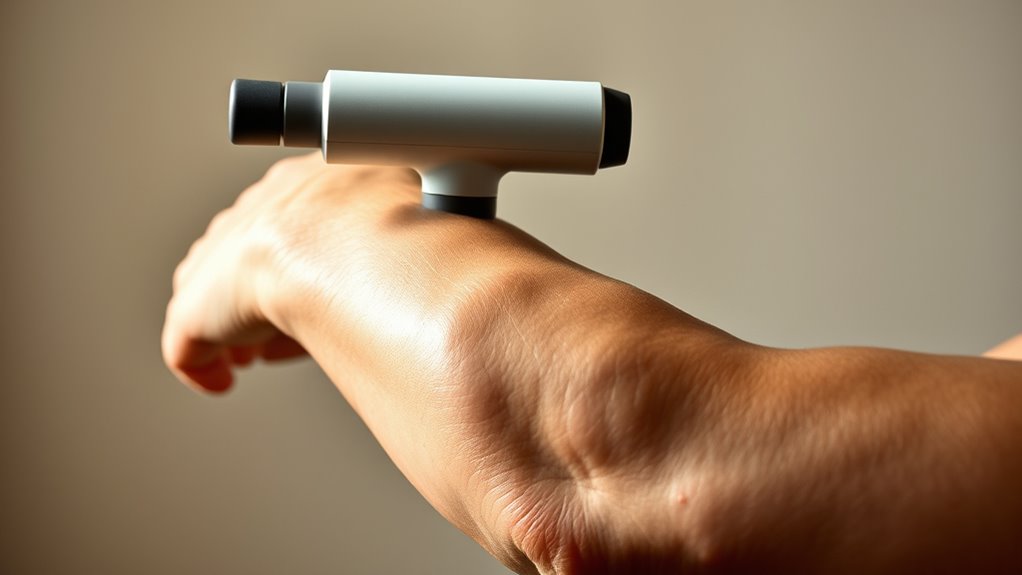
Using massage guns improperly can cause skin irritation or even damage if you press too hard or use them for too long. You also risk nerve injury if you target sensitive areas without proper knowledge. To avoid these hazards, make sure you understand correct technique and limit overuse.
Skin Damage Potential
While massage guns can offer effective relief when used properly, overuse or misapplication can lead to skin damage. Excessive pressure or prolonged use can compromise skin integrity, increasing the risk of abrasions or bruising. Your skin’s epidermal sensitivity can vary, making certain areas more prone to irritation or injury. If you press too hard or target the same spot repeatedly, you may cause micro-tears or inflame the skin’s surface. It’s important to pay attention to your skin’s response and avoid prolonged contact with a single area. Proper technique, gentle pressure, and moderation can help prevent these issues. Additionally, using appropriate attachment heads and following manufacturer guidelines can minimize the risk of damage. Remember, skin damage isn’t always immediately visible, but repeated misuse can weaken your skin’s protective barrier over time.
Nerve Damage Risks
Overusing massage guns or applying them improperly can pose a serious risk of nerve damage. Excessive pressure or prolonged use may irritate nerves, especially in areas with high nerve sensitivity. This can hinder nerve regeneration and cause lasting discomfort or numbness. Understanding the risk factors helps prevent nerve injury:
| Risk Factor | Effect | Prevention |
|---|---|---|
| Overuse | Nerve irritation and damage | Limit session duration |
| Incorrect placement | Targeting nerves directly | Use proper technique |
| Excessive pressure | Compression of nerve tissues | Apply gentle, controlled force |
| Sensitive areas | Increased vulnerability to injury | Avoid high pressure over nerves |
Knowing these risks, you can avoid damaging your nerves and ensure safe, effective recovery. Additionally, being aware of your specific tuning needs can help prevent overexertion and injury during treatment.
Improper Technique Hazards
Improper technique when applying massage guns can quickly lead to overuse and misapplication, increasing the risk of nerve injury. Without proper manual dexterity, you might press too hard or hold the device in one spot too long, causing tissue damage. Relying solely on a massage gun also reduces the opportunity for emotional support and connection, which are essential in healing and relaxation. Overusing the device can lead to muscle soreness, bruising, or nerve irritation, especially if you ignore your body’s signals. Mistakes in technique can exacerbate these issues, making recovery longer. Remember, massage guns aren’t a substitute for the nuanced touch and attentiveness of a trained professional. Proper technique is fundamental to avoid hazards and ensure safe, effective relief.
The Role of Empathy and Human Connection in Healing
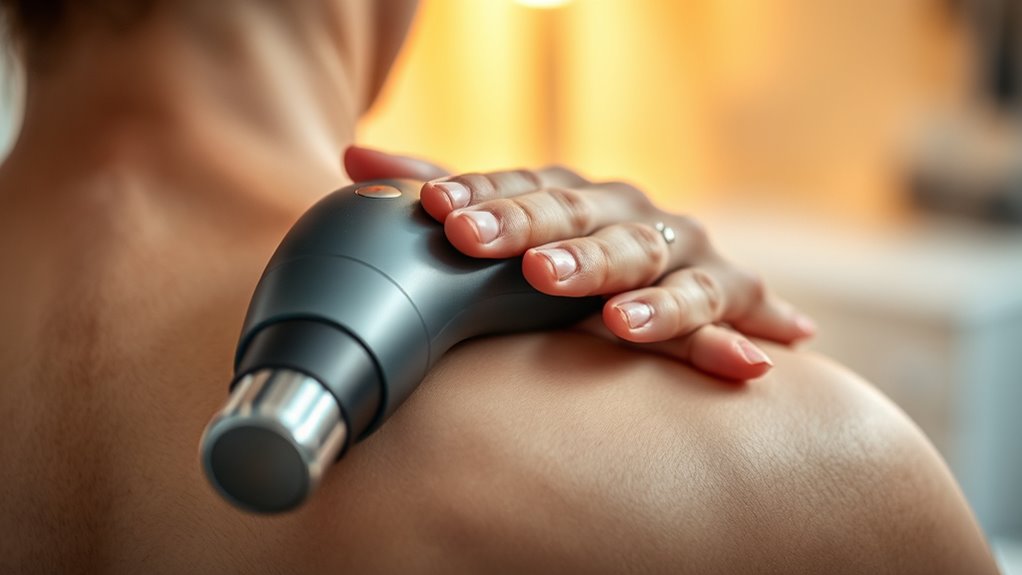
Empathy and human connection play a pivotal role in the healing process, often surpassing the effects of physical treatments alone. When you receive emotional support and genuine attention, you feel more comfortable and open to healing. Building trust with your therapist creates a safe space, allowing deeper relaxation and more effective recovery. Here are three reasons why human connection matters: 1. It fosters emotional support, reducing anxiety and stress. 2. Trust building encourages honesty about your symptoms, leading to better care. 3. Genuine human interaction boosts motivation and adherence to treatment plans. Additionally, engaging in music therapy for emotional expression can complement physical treatments by addressing emotional well-being. While massage guns can provide relief, they lack the ability to connect emotionally, which is essential for holistic healing. Your human therapist understands your needs on a personal level, making a significant difference.
Complementing Therapy, Not Replacing It

While massage guns offer effective relief for muscle tension and soreness, they should be viewed as a complement to traditional therapies rather than a replacement. Massage technology can target specific areas quickly, but it lacks the nuanced understanding that human intuition provides. You can’t replicate the sense of touch, empathy, and adaptability that a trained therapist offers. Human hands can adjust pressure based on real-time feedback, ensuring comfort and safety. Incorporating manual therapy alongside device use allows for a more personalized approach. Combining massage guns with manual therapy creates a more all-encompassing approach, maximizing benefits while minimizing risks. Think of massage technology as a helpful tool, but not a substitute for the personalized care and insight that only human touch can deliver. Together, they work best in supporting your overall healing and well-being.
Frequently Asked Questions
Can Massage Guns Effectively Target Deep Tissue Layers?
You might wonder if massage guns can effectively target deep tissue layers. While they deliver rapid percussive therapy, they lack the nuanced touch of a therapist’s personalized care. Therapeutic touch allows a professional to feel muscle tension and adjust pressure accordingly, ensuring deeper, targeted relief. Massage guns provide some benefits, but they can’t replace the precision and adaptability of human hands for deep tissue work.
How Do Human Hands Adapt to Individual Patient Needs?
Imagine a patient with tender shoulder muscles; your hands intuitively adjust pressure based on their feedback. You tailor manual therapy to meet individual needs, ensuring ideal patient comfort. Unlike massage guns, your hands adapt instantly to muscle tone and pain levels, providing nuanced care. This ability to sense and respond makes human hands indispensable, as they deliver personalized treatment that machines can’t replicate, enhancing therapy effectiveness and patient satisfaction.
What Are Signs of Tissue Overstimulation From Devices?
If you notice overstimulation symptoms, your body might react with increased soreness, tingling, or numbness. Device indicators like excessive vibration or pain during use also signal overstimulation. You should stop immediately if these signs appear, as continued use can cause tissue damage. Pay attention to your body’s responses, and adjust the device’s intensity or duration to prevent overstimulation symptoms and protect your tissues from harm.
Are There Specific Conditions Contraindicated for Massage Guns?
When it comes to contraindications for massage guns, you should tread carefully around certain conditions. If you have active skin infections or severe skin sensitivity, using a massage gun can do more harm than good. Trigger points in muscles may benefit, but avoid use if you have deep vein thrombosis, open wounds, or fractures. Always consult a healthcare professional to ensure safety, because some issues are better left untouched.
How Does Emotional Support Influence Physical Healing Outcomes?
You might not realize it, but emotional support plays a vital role in physical healing. When you feel emotionally comforted, your body responds better, reducing stress and promoting recovery. A therapeutic connection with a caregiver or loved one boosts your confidence and motivation, which can enhance healing outcomes. So, fostering emotional support isn’t just about feeling good — it actively influences your body’s ability to heal and regain strength.
Conclusion
Remember, massage guns may mimic movement, but they can’t match the magic of human touch. Personalize your practice, prioritize proper pressure, and pay attention to tissue signals. Avoid accidents by applying awareness and avoiding overuse. Ultimately, human hands heal with empathy, energy, and expertise, fostering trust and true therapy. So, embrace the balance—blend the benefits of devices with the depth of dedicated, deliberate, and compassionate care for genuine growth and genuine relief.
